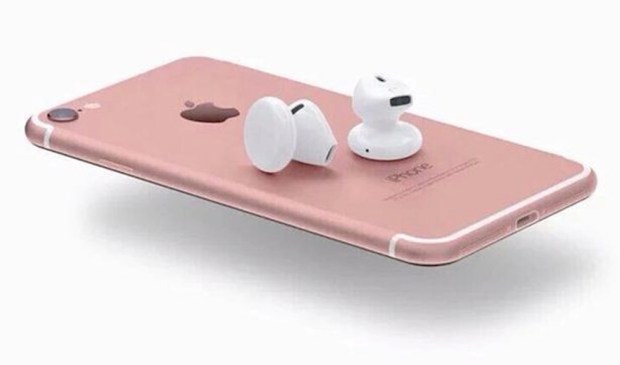The iPhone 7 Is Here — The World Rejoices?

After much fanfare and speculation, the big day finally came. The new iPhone 7 was unveiled to the world.
Sure, other things happened at Apple’s annual fall presentation — Apple Pay moved into Japan, the Apple Watch Series 2 is coming soon (and in white), Nintendo fans got all kinds of goodies — but since the iPhone is the engine of the Apple revenue-generation machine, all eyes are always on the iPhone.
So, what judgement was passed on the iPhone 7?
Well, Tim Cook really likes it…
“This is the best iPhone we’ve ever created,” the Apple CEO told an audience of reporters and Apple employees at yesterday’s event.
Cook’s opinion was a bit brighter than those who were on scene for the great unveiling, none of whom reported having seen “the best iPhone Apple has ever built.”
Which isn’t to say the world hated what it saw. Most reviews offered some variation on The New York Times’ Farhad Manjoo’s thoughts: Not bad, maybe some interesting ideas but not a whole lot to get excited about right now.
“[Apple] clearly has deep, long-term plans for the iPhone … The problem for Apple is that the steps along the way to achieving its goals aren’t always that exciting. This is one of those years.”
That less-than-glowing praise dovetailed nicely with the market’s less-than-elated reaction. Apple stock blipped up a mere 1 percent following today’s product announcement — a far cry from the over 20 percent Apple saw in the hours after the iPhone 6 got its first introduction to the world.
“The iPhone 7 packed few surprises,” said Jan Dawson, an independent analyst for Jackdaw Research. “This event was a big test of Apple’s ability to continue to tell a compelling story around its annual product upgrades.”
So, what did that story sound like?
Arrivederci, Headphone Jack — A 3.5mm Bridge Too Far
The biggest surprise on call today at the Apple event didn’t come as much of a shock, since it was so widely anticipated that Steve Wozniak was able to start complaining about it weeks ahead of yesterday’s event. But the rumors did turn out to be true: Apple is saying goodbye to the 3.5mm headphone jack.
Why? Courage.
No really, that’s what it said.
“The reason to move on comes down to one word: courage,” Philip Schiller, Apple’s senior vice president for marketing, said on Wednesday (Sept. 7). “The courage to move on, do something new that betters all of us.”
Apart from Apple’s desire to be remembered in the same vein as Rosa Parks, the guy who stood up to the tanks at Tiananmen Square and Captain Sully Sullenberger, the real story behind the removal of the 3.5mm headphone jack was a space-saving mechanism that allowed for the inclusion of a faster processor and better battery life, while making the device water- and dust-resistant.
To make the transition easier for its customers, Apple is also releasing its very own, very snazzy wireless headphones. Using its own W1 chip, Apple designed AirPods that connect to the iPhone without needing to pair, like you would with Bluetooth — just wave them near the iPhone and they’re good to go. However, Apple is not including them with the iPhone; those will set the user back an additional $150. If that seems a bit steep for users, Apple is including a dongle for the lightning port that users can plug their old-school headphones into.
That’s nice.
The headphone was the biggest change. Most of the other announced upgrades to the iPhone were somewhat incremental. The iPhones have a new processor that is about 40 percent faster than the previous models. Battery life has reportedly been increased by two hours. The “home” button is now pressure-activated instead of mechanically pushed.
The camera is also somewhat upgraded with a wider color spectrum. IPhone 7 Plus buyers will get two cameras on the rear that work together to improve zooming capability.
The buzzword of the day was “incremental improvement,” with a lot of allusions to the wireless future. The challenge Apple faces now is convincing the buying audience that all these improvements will add up to something innovative and amazing in a future instantiation.
Other Goodies
While the iPhone news didn’t exactly set the world abuzz, there were some interesting tidbits mixed in. Payments peeps got the official confirmation that Apple Pay is going to Japan and will be forsaking NFC tech in favor of the more popular “FeliCa” contactless payments platform developed by Sony.
And only used in Japan.
Apple also confirmed that Apple Pay will debut in New Zealand in October and in Russia sometime in the fall.
Additionally on Wednesday, Apple’s marketing chief noted that “over 90 percent of contactless payments handled by U.S. merchants are with Apple Pay,” when compared to to rival services Android Pay and Samsung Pay.
And we know how many that is, too. It’s not many.
The most attention-grabbing news of the day wasn’t actually about Apple. It was about Nintendo.
Apple may not have seen a big bounce out of this meeting for its stock price, but Nintendo sure did. Nintendo’s U.S.-listed shares jumped 29 percent on Wednesday after the gaming company officially announced its plans to bring several titles to Apple’s various mobile platforms.
Nintendo plans to release a version of its co-owned Pokémon GO augmented reality game to the Apple Watch and an “endless runner” style game using Mario Bros. characters called “Super Mario Run” exclusively to Apple’s App Store.
And that, it seems, is the main issue Apple is facing coming out of today’s developer conference: Nintendo basically stole the show.
Maybe everyone will love jack-free phones, or the sharper camera will change how we all view the world.
But it seems, for now, that many people who bought an iPhone 6 are going to stick with it. The PYMNTS Twitter poll on the subject found our audience evenly divided between enthusiasm for the new and a willingness to sit this one out and wait for the next one.
Which means this Christmas might not be nearly so merry for Apple as the one that followed the release of the iPhone 6, since the enthusiasm thus far just isn’t there.
Of course, the headphones aren’t out yet, and so, perhaps we just haven’t fully appreciated Apple’s courage.
And even if we don’t, if the iPhone 7 doesn’t convince a massive number of people to fork over another $600–$700 for a new phone, it’ll at least have a new set of revenue from all the $150 AirPods and one-off replacements it will sell as people inevitably lose them.
